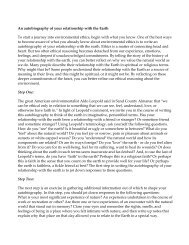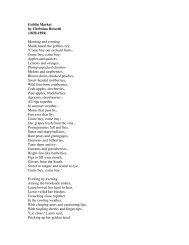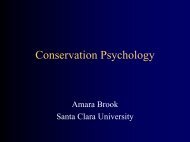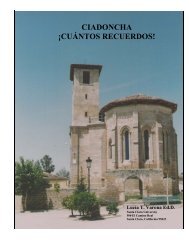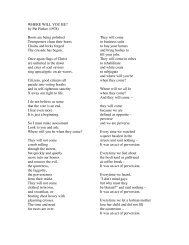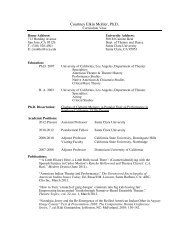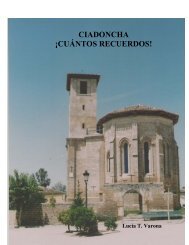ciadoncha; ¡cuántos recuerdos - Webpages at SCU - Santa Clara ...
ciadoncha; ¡cuántos recuerdos - Webpages at SCU - Santa Clara ...
ciadoncha; ¡cuántos recuerdos - Webpages at SCU - Santa Clara ...
Create successful ePaper yourself
Turn your PDF publications into a flip-book with our unique Google optimized e-Paper software.
this town. The stories are only engraved in the memories of those th<strong>at</strong> live. We could say<br />
th<strong>at</strong> every time an elder of Ciadoncha dies, a library disappears with him or her; th<strong>at</strong><br />
library th<strong>at</strong> until today the town has never had. Before this reality and with the certainty<br />
of the large values th<strong>at</strong> are in this place I began the present work. This is a compil<strong>at</strong>ion<br />
of the most pleasing memories of twenty two people th<strong>at</strong> kindly accepted my invit<strong>at</strong>ion to<br />
dialogue. Only one of them asked th<strong>at</strong> his name not appear in the list of participants.<br />
Wh<strong>at</strong> I contribute to this study is the historical context of the times to which the<br />
narr<strong>at</strong>ions of the informants refer and also my own reflections and memories.<br />
Form in which quotes and bibliographical references have been done.<br />
It is my dream th<strong>at</strong> this study be read by all the people th<strong>at</strong> want to enter in some<br />
way in the marvelous ordinary, but not simple, world or those who make it possible for<br />
bread to come to our table every day. Th<strong>at</strong> is why the reader will realize th<strong>at</strong> the<br />
language used is colloquial and direct. In the text the authors are mentioned and the<br />
number th<strong>at</strong> you see in parenthesis corresponds to the page from which the inform<strong>at</strong>ion<br />
comes. The d<strong>at</strong>a of the sources of inform<strong>at</strong>ion are given <strong>at</strong> the end in the form of a<br />
bibliography. Many terms and words are written in italic, which means th<strong>at</strong> the<br />
explan<strong>at</strong>ion for this word or phrase is loc<strong>at</strong>ed in the glossary <strong>at</strong> the end.<br />
When I refer to personal dialogues, I do not write the name of the person, but I do<br />
give the year in which the interview took place. This is <strong>at</strong> the request of the participants,<br />
whom only want their names to appear as collabor<strong>at</strong>ors, but do not want wh<strong>at</strong> each said<br />
to be individually identified.<br />
In which inform<strong>at</strong>ion is found on the Internet, the electronic address is given and<br />
a brief explan<strong>at</strong>ion of the same in the text. In the bibliography the address is given again<br />
and the d<strong>at</strong>e th<strong>at</strong> it was used.<br />
With respect to the photographs used in this study, the majority was provided by<br />
Arcadio and Federico Varona, and others th<strong>at</strong> wanted to collabor<strong>at</strong>e; and yet others were<br />
taken by the author. In each photograph, its origin is mentioned. In many cases it is<br />
impossible to know the d<strong>at</strong>e in which they were taken and one can only make a reference<br />
to its era or the decade in which we assume they were taken. Those which were able to<br />
be given a d<strong>at</strong>e have only the year.<br />
Theoretical Bases<br />
Particip<strong>at</strong>ory research theory, appreci<strong>at</strong>ive inquiry theory, and oral history theory<br />
have served as a base for this study. These three vast research theories have inspired and<br />
helped me observe, reflect, learn to ask and organize inform<strong>at</strong>ion.<br />
Peter Park, a North American investig<strong>at</strong>or who has done a lot of studies with<br />
different communities in the United St<strong>at</strong>es explains th<strong>at</strong> the theory of Particip<strong>at</strong>ory<br />
Research says th<strong>at</strong> the need for research comes from the people in the community. It is<br />
the people who have the power to gener<strong>at</strong>e, deepen and transmit knowledge (4). He says<br />
th<strong>at</strong> particip<strong>at</strong>ory research begins because the people see a problem and try to solve it.<br />
The investig<strong>at</strong>or with the people from the community (I have placed this emphasis) see<br />
5





